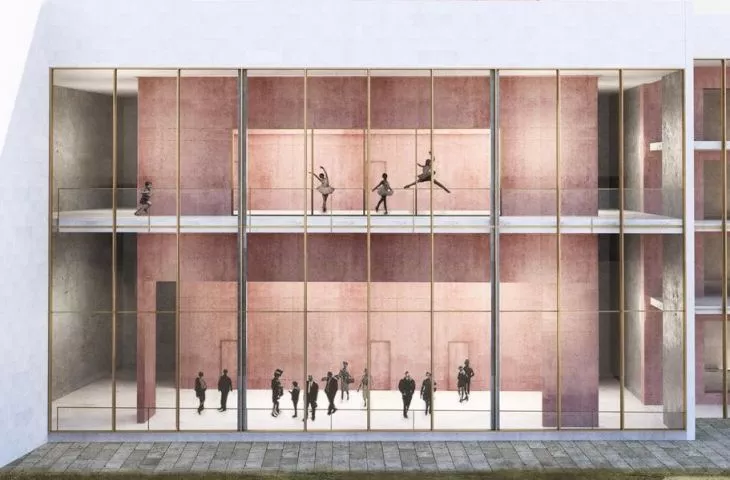Inspired by the teachings of Socrates,Zuzanna Robutka designed a facility to facilitate social dialogue and popularize philosophy and its teachings. As a place for the Socratic Dialogue Center, she proposed the Wroclaw district of the Four Faiths, in keeping with the trend of revitalization and densification of the urban fabric.
The work was created under the supervision of Dr. Marek Lamber at the Faculty of Architecture of the Wrocław University of Technology. The author's goal was to create a facility for events related to philosophy and culture, inviting dialogue between different social groups.
A cross-section of the Socratic Dialogue Center
© Zuzanna Robutka
As Zuzanna Robutka explains:
Philosophy is a word with Greek etymology meaning exactly the love of wisdom. As a science, philosophy tries to define like a general view of the world. Its scope, the most extensive and general of all sciences, tries to go beyond partial considerations. Philosophy shapes the ability to think independently and critically, develops abstract thinking, teaches how to ask the right questions and seek answers. I decided to dedicate the project of a social center in the Four Faiths district of Wroclaw to one of the greatest philosophers of antiquity - Socrates. The way of transferring knowledge and skills in a direct exchange of experiences inspired the creation of the functional program of the building.
intercultural dialogue
The designed building is located in Wrocław's Four Faiths district, in the courtyard of the quarter delineated by the streets - Włodkowica, St. Anthony and Krupnicza and in the immediate vicinity of the White Stork Synagogue. Two other well-known Wrocław backyards - the Wrocław Neon Gallery and Pasaż Niepolda - are also located nearby. The development of the area is therefore in line with the trend of revitalizing quarters in the Old Town area and densifies the existing urban fabric. The building does not overwhelm the neighboring synagogue - it creates a complement and background for it.
The main goal of the project is to establish a dialogue between different social and cultural groups
© Zuzanna Robutka
philosophy an inspiration for architecture
The main idea of the project is to establish a dialogue between different social and cultural groups. The teaching of Socrates Zuzanna Robutka tried to reflect in every aspect of the proposed building, in the functions and spaces connecting them, accessibility and openness. In his teaching, Socrates used two methods positive - majeutic and negative - elenctic which was directly reflected in thestructure of the building. The author grouped the various functions in four cuboids surrounded by communication on all sides.
individual functions are mixed in four cuboids
© Zuzanna Robutka
Thedisjointed body of the building was strongly determined by the difficult conditions of the plot. The entrance to the building is located in an arcade on the side of the passage between St. Anthony and Wlodkowica Streets. The architect complemented the passage's frontage, emphasizing its narrow character and view axis. Functions in the building are arranged in four cuboidal areas, grouping them from the most public to private - catering, representative, workshop and craft studios.
The second floor houses the restaurant's kitchen, dishwashing room, storerooms and social facilities for café employees. Above the restaurant there is a technical floor for the installations of the catering part. The last floor is the restaurant room, along with an exit to the green roof.
The height of the objects is variable and depends on the function
© Zuzanna Robutka
Socratic Dialogue Center
The most exposed object is a representative cuboid containing a two-story auditorium on the first floor and at level -1, while other halls are located on the first floor and an exhibition hall on the roof. The basement area of another cuboid contains a neighborhood meeting room. The first floor of this section is an open foyer space for the synagogue and the auditorium of the Socratic Dialogue Center. The floors house a dance hall with facilities, workshop rooms, and on the top floor the training rooms of the language school. In the building of the former granary, the author proposed craft workshops.
cafe space
© Zuzanna Robutka
The height of the blocks is variable and depends on the function. The rooms requiring access to daylight are located on the higher floors, taking into account the high shading inside the quarter. The architect lowered part of the floor so as to equalize the levels between the existing buildings and allow free communication. The recessing of part of the building also made it possible to distinguish the private part of the courtyard of the townhouses from the public space of the center. Each of the perpendiculars is distinguished by a red color that repeats for a given function. This allows for simple identification and provides a visual link between the different parts of the site. The gradation of spaces from the most public to private encourages users to freely explore the building and walk to the other side of the quarter.
The project made it to the finals of this year's Zbyszek Zawistowski "Diploma of the Year" Award, the results of which will be announced in October. In addition to this work, other nominees for the award include Tomasz Kruszyński , author of the work titled INVISIBLE SACRUM, Adam Grudzień and Iga Jagodzinska with a project for a craftsmen's settlement in Kashubia , and Konrad Lepak with a project for a hotel on the Solina Reservoir.
compiled by: Dobrawa Bies
illustrations courtesy of Zuzanna Robutka



















































